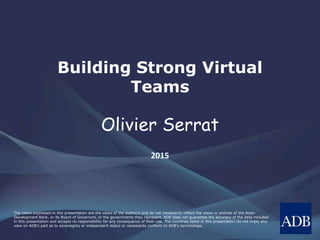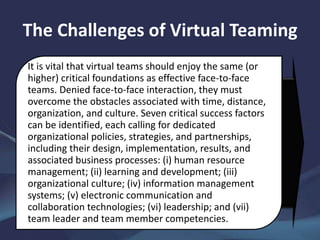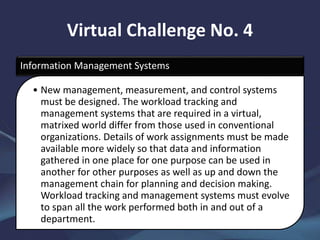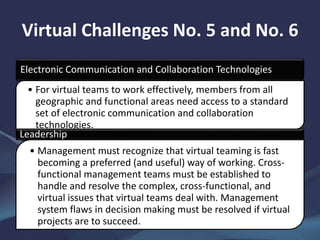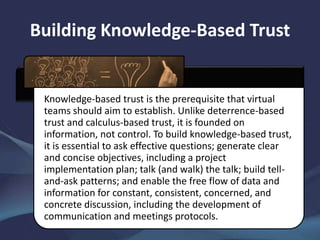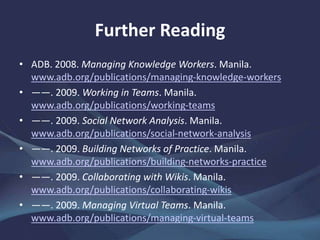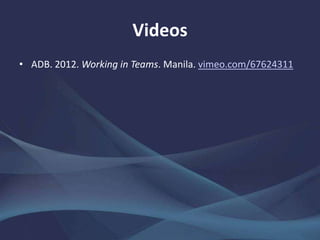Building Strong Virtual Teams
- 1. The views expressed in this presentation are the views of the author/s and do not necessarily reflect the views or policies of the Asian Development Bank, or its Board of Governors, or the governments they represent. ADB does not guarantee the accuracy of the data included in this presentation and accepts no responsibility for any consequence of their use. The countries listed in this presentation do not imply any view on ADB's part as to sovereignty or independent status or necessarily conform to ADB's terminology. Building Strong Virtual Teams Olivier Serrat 2015
- 2. On Organizing Organizing is a key activity in life and organizations are its most visible manifestation. An organization happens when people come together and match up with commitment and trust. So, why exactly do people form groups? People try to accomplish with others what they cannot do alone. Apart from the anticipated social, political, economic, and cultural benefits of cooperation, a principal stimulus of organization is competition; after all, if resources were unlimited the need to organize would be minimal.
- 3. Define: Team At its best, a team is a cooperative unit of interacting individuals who are committed to a common purpose on tasks; endowed with complementary skills, for instance, in technical competence, problem-solving ability, and emotional intelligence; and who share interdependent performance goals (with indicators and deadlines) as well as an approach to work for which they hold themselves mutually accountable.
- 4. On Team Chemistry When they are effective, teams are typified by intelligibility of purpose, trust, open communication, clear roles, the right mix of talent and skills, full participation, individual performance, quality control, risk taking, collective delivery of products and services, an appropriate level of sponsorship and resources, and (ideally) balanced work–life interactions. Their stages of development are likely universal: All groups develop in five stages beginning with membership, working through subgrouping, confrontation, and differentiation to the more effective form of shared responsibility.
- 5. The Advent of Virtual Teams Thanks to globalization and, chiefly, the advent of the internet, unusual teams have emerged: they span private homes, hotel rooms, far-flung offices, and electronic workspace. Indeed, their members may never meet face-to-face. In virtual teams, knowledge workers can balance work and leisure and link with more people; with virtual teams, organizations can tap wider talent pools and cut real estate costs. However, the distinct configurations of virtual teams raise unique challenges for managers, to which literature and practice are only just beginning to pay attention.
- 6. Virtual and Face-to-Face Team membership is fixed. All team members are drawn from the organization. Team members are dedicated full-time to the team. Team members are co- located organizationally and geographically. Teams have fixed starting and ending points. Teams are managed by a single manager. Team membership shifts. Team members can include people from outside the organization. Most team members are members of multiple teams. Team members are distributed organizationally and geographically. Teams form and reform continuously. Teams have multiple reporting relationships with different parts of the organization, and often with other organizations, at different times. From To
- 7. The Challenges of Virtual Teaming It is vital that virtual teams should enjoy the same (or higher) critical foundations as effective face-to-face teams. Denied face-to-face interaction, they must overcome the obstacles associated with time, distance, organization, and culture. Seven critical success factors can be identified, each calling for dedicated organizational policies, strategies, and partnerships, including their design, implementation, results, and associated business processes: (i) human resource management; (ii) learning and development; (iii) organizational culture; (iv) information management systems; (v) electronic communication and collaboration technologies; (vi) leadership; and (vii) team leader and team member competencies.
- 8. Virtual Challenge No. 1 Human Resource Management • Human resource management must resonate with virtual knowledge workers and deal with unique issues such as visibility in the organization, career options, and paths to advancement. Virtual staff need to feel they are on a par with other workers in the organization and that their different personal and work circumstances are understood. Human resource management must overcome the perceived natural advantage of in-house employees, with possible implications for organizational design. Lack of a sense of belonging can show up in human resource indicators, such as low morale and retention.
- 9. Virtual Challenges No. 2 and No. 3 Learning and Development • Modern organizations must commit to, and make resources available for, training and other ongoing learning development activities focused on working in a virtual environment. They must also educate all employees, not just virtual employees, in virtual team culture. Organizational Culture • Leadership and organizational commitment must recognize that virtual teaming is fast becoming a preferred way of working. Recognition entails promoting virtual teaming and rewarding and recognizing team members who lead and participate in virtual teams.
- 10. Virtual Challenge No. 4 Information Management Systems • New management, measurement, and control systems must be designed. The workload tracking and management systems that are required in a virtual, matrixed world differ from those used in conventional organizations. Details of work assignments must be made available more widely so that data and information gathered in one place for one purpose can be used in another for other purposes as well as up and down the management chain for planning and decision making. Workload tracking and management systems must evolve to span all the work performed both in and out of a department.
- 11. Virtual Challenges No. 5 and No. 6 Electronic Communication and Collaboration Technologies • For virtual teams to work effectively, members from all geographic and functional areas need access to a standard set of electronic communication and collaboration technologies. Leadership • Management must recognize that virtual teaming is fast becoming a preferred (and useful) way of working. Cross- functional management teams must be established to handle and resolve the complex, cross-functional, and virtual issues that virtual teams deal with. Management system flaws in decision making must be resolved if virtual projects are to succeed.
- 12. Virtual Challenge No. 7 Human Resource Management • Team leaders must see themselves as critical to facilitating the team's success, with a particular role in bringing the team closer together and building the interpersonal relations its members need to succeed. Just as importantly, team members must be proficient in the use of interactive technologies—working across time, distance, organization, and culture with sensitivity to project and time parameters—and able to network.
- 13. Building Trust Shared culture, social context, and values; physical proximity; information exchange; and time foster trust. These conditions are not met in the context of virtual teams. In a virtual environment, trust is based more on (ability and) delivery of tasks than on interpersonal relationships. Members of virtual teams need to be sure that others will behave in a consistent, predictable manner and fulfill their obligations with competence and integrity. Trust is a much more limiting factor in virtual teams, compared with face-to-face teams. Therefore, it is helpful to recognize its typologies. The range covers deterrence-based trust, calculus-based trust, knowledge-based trust, and identification-based trust.
- 14. Building Knowledge-Based Trust Knowledge-based trust is the prerequisite that virtual teams should aim to establish. Unlike deterrence-based trust and calculus-based trust, it is founded on information, not control. To build knowledge-based trust, it is essential to ask effective questions; generate clear and concise objectives, including a project implementation plan; talk (and walk) the talk; build tell- and-ask patterns; and enable the free flow of data and information for constant, consistent, concerned, and concrete discussion, including the development of communication and meetings protocols.
- 15. New Management Mind-Sets Face-to-face is the best environment for interaction and anything else is a compromise. Collaboration is what happens when teams interact at a fixed time and in a fixed space. Being people-oriented is incompatible with using technology. When the communication process breaks down, blame the technology. Learning to manage virtual teams is about learning how to use the technology. Different kinds of environments can support high-quality interaction. What matters is how you use them. Collaboration happens in an ongoing, boundaryless way. Using technology in a people-oriented way is possible and desirable. When the communication process breaks down, evaluate management and interaction strategies, not just the technical tool. Learning to manage virtual teams is about understanding more about teams and the collaboration process. From To
- 16. Further Reading • ADB. 2008. Managing Knowledge Workers. Manila. www.adb.org/publications/managing-knowledge-workers • ——. 2009. Working in Teams. Manila. www.adb.org/publications/working-teams • ——. 2009. Social Network Analysis. Manila. www.adb.org/publications/social-network-analysis • ——. 2009. Building Networks of Practice. Manila. www.adb.org/publications/building-networks-practice • ——. 2009. Collaborating with Wikis. Manila. www.adb.org/publications/collaborating-wikis • ——. 2009. Managing Virtual Teams. Manila. www.adb.org/publications/managing-virtual-teams
- 17. Videos • ADB. 2012. Working in Teams. Manila. vimeo.com/67624311
- 18. Quick Response Codes @ADB @ADB Sustainable Development Timeline @Academia.edu @LinkedIn @ResearchGate @Scholar @SlideShare @Twitter
